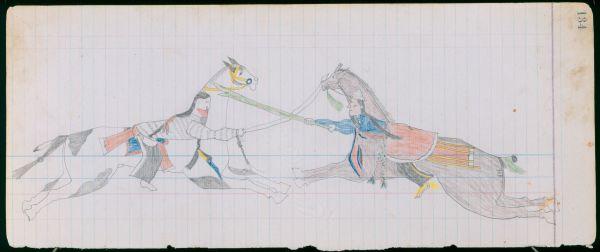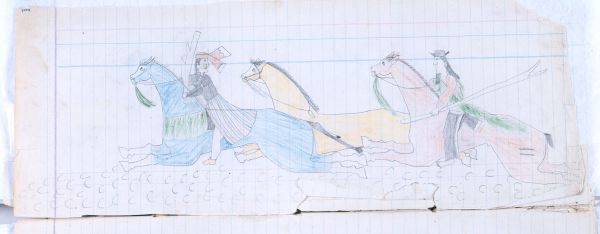PLATE 134
Ethnographic Notes
The sequence illustrated in Plates 134, 136 & 137, like the earlier event depicted in Plate 124, shows vignettes during the sham battle waged among representatives of the warrior societies on the first day of the Medicine Lodge ceremony, when the cottonwood posts to build the structure were cut and hauled to the site, along with necessary willow and cottonwood greenery. After that labor had been performed, the sham battle occurred---a symbolic sporting event which contributed a secular intermission to a long day of serious ritual.
When George Bird Grinnell witnessed such a sham battle at the Southern Cheyenne Sun Dance of 1902, each of the warrior society members selected an opponent from a competing society, and each pair reverted to their boyhoods to play a spirited version of the Kicking Game, leaping at each other with feet forward and kicking at the opponent. Several sallies might be required before one man was knocked off his feet. The victor might shout "Ah haih'!" (I have struck first!), as was done when achieving a coup in battle. All this was said to bring good luck in war during the coming season (Grinnell, 1923, II: 229-31).
Each warrior society selected two of its members to be their "color bearers", or primary combatants, and these were mounted on horseback, armed with willow or cottonwood cudgels for a staged combat within the great circle of the camp. Grinnell remembered seeing "six or eight" riders in the contest (certainly there would have been eight, two each from the Crooked Lances, Kit Foxes, Dog Soldiers and Bowstrings; or in the North, the Crazy Dogs).
In these drawings, then, Arrow has depicted nearly the whole equestrian combat. Grinnell insisted: "Sometimes in sport the willow weapons were used; but the young men were careful in using them, no severe blows were given, and all were good tempered." Of this contest thirty years earlier, Arrow's drawings tell a somewhat different tale. One man has already been felled at full gallop from the buckskin in Plate 137, and Arrow is holding the club which struck the blow, a sham (but formidable) version of the Elk Society's black and yellow, serrated quirt shown in Plates 163 & 165.
Arrow identifies himself by the small, black-tipped feather tied in his horse's wrapped tail. This fork-earred, blue roan has a breastband formed of willow leaves, imitative of the mirrored breastband Arrow used in Plate 2. He wears the same dark shirt and silver armbands shown there, as well. Arrow is bare-legged, with a striped blanket around his waist, and wears undecorated moccasins, in case he should get dumped in the dirt. Around his head, Arrow has tied a broad strip of red wool trade cloth, to keep his unbound hair from blowing into his eyes. Tied to the jaw loop of his horse's war bridle is a "scalp" formed of willow leaves, in imitation of the real scalp Arrow depicts in Plate 27.
Arrow's purpose in these compositions is to show that he and his Nisson comrade upheld the honor of the Elk, or Crooked Lance Society. Once again, as in the earlier year shown in Plate 124, they have been selected to represent their fellows. This testifies directly that the two were among the bravest and most-active fighters during the warfare of 1874-75. Their formal dress depicted in Plate 163 shows this as well: the comrade had been awarded the right to wear a scalplock shirt, and Arrow carried one of the Elk Society straight lances.
In Plate 137, the missing rider of the buckskin probably belonged to the Dog Soldiers, for the man at the right---who is hot on Arrow's trail---is shown to be a Dog Society Sash Wearer by the imitation sash of plaited willow withes trailing from his shoulders. His weapon is imitative of a forked Vikuts, or water-carrier's lance, such as is shown in Plate 13. Both Dog Soldier horses also have imitation "scalps" tied below their jaws; and the strawberry roan has a distinctive decoration of red silk ribbons tied through holes punched in its ears.
The many tracks show that these riders have been over a tight course several times. One suspects that Arrow's luck is about to run out---else he would have shown himself in a further drawing upending the second Dog Soldier. The pursuer ultimately will draw close enough that with a deft prod and twist of the Vikuts, Arrow will be launched from his seat, and have the unpleasant experience of crashing to the ground while another man shouts: "Ah haih'!"
While Arrow is occupied in Plate 137, his Nisson comrade is performing wonders elsewhere on the field. Dressed identically in Plates 134 & 136, we recognize him from the slouch hat with blue-painted spots that he wore in Plates 90 & 100. Here, he has painted his face a light red, and has a black-cross star marked on each cheek. He wears the same, dark blue trade cloth leggings with an added stripe of yellow silk that we saw in Plate 94. For this festive battle he has donned a long, red breechcloth ornamented with four stripes of yellow-silk applique; and has a red trade cloth blanket secured around his waist with a braided sash of red and blue yarn. His partly-beaded moccasins have the tops and long heel fringe painted yellow. A red and blue silk scarf is tied above his left elbow, to accent the blue shirt. One suspects it may have been a gift from his sweetheart.
The comrade's horse is the same, fork-earred, black stallion or gelding he rode in Plates 104 & 106. Here, he has painted three, short black lines on the left haunch, below the tail. While we cannot be certain of the exact meaning of this motif, certainly it was intended as protective, and probably designed to invoke speed.
In Plate 134, the comrade jousts with an opponent from another warrior society. Since the Dog Soldiers in the contest are accounted for in Plate 137, the red paint across this man's mouth---as if he had been eating at a bloody kill---suggests that he may be a Kit Fox. From the positions of the combatants' two, green-willow cudgels, we are meant to perceive that the bout is already decided: the opponent's stave has been batted down, and to the side. In another second when the horses close, the stave will be ripped from his grasp. Simultaneously, the Elk warrior has inserted his own stave between the opponent and his horse; as they pass, the Elk will thrust down and to the left, and the opponent must fall.
The trapezoidal shape, and red-and-blue colors of this man's saddlecloth suggest that it is a captured U.S. Army shabrack of the Artillery Corps---compare Plate 104.
In Plate 136, Arrow's Elk Society comrade continues to decimate the field, moving up behind another Cheyenne---probably one of the Bowstrings---who carries a woven-willow shield on his back. As this man strikes backward with his elk-antler pony whip, lashing his opponent across the throat and chest, the Elk warrior grabs the left side of his victim's hair, symbolically scalping him. A quick tug backward, and the Bowstring will be lying on the prairie with the wind knocked out of him. At the left, another Bowstring charges, but too late to save his partner. Note the many blue stripes, denoting first coups, painted on these two horses. Their riders are accomplished warriors, whose own downfall---in jest though it may be---adds to the reputation of the Elk Society.


